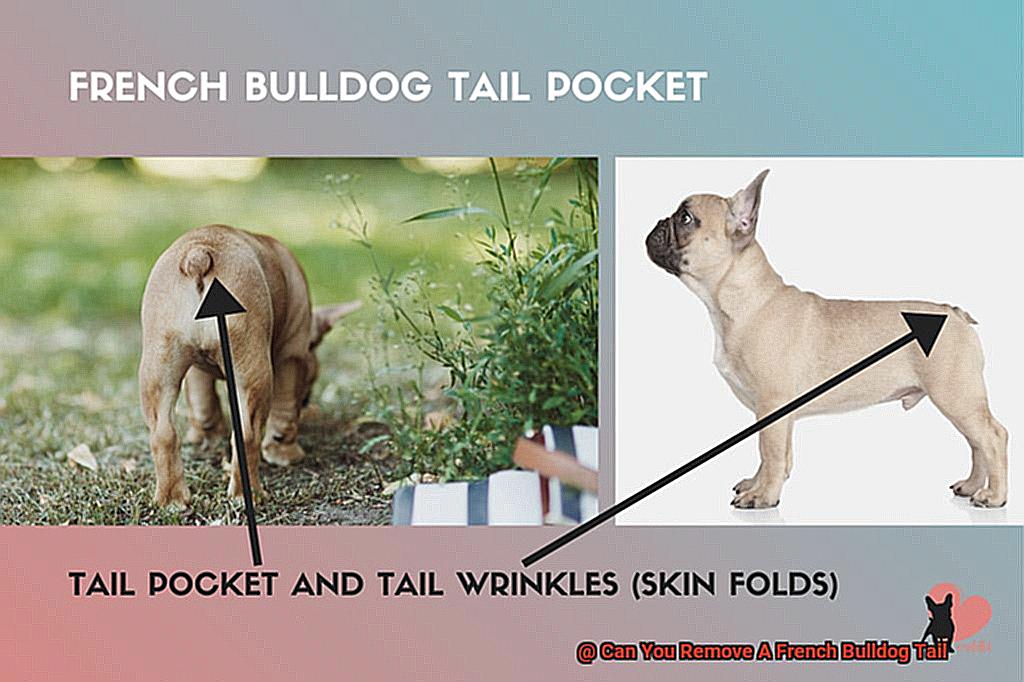Can You Remove A French Bulldog Tail?
The French Bulldog – those squishy-faced, bat-eared bundles of joy. But what about their tails? Some owners find themselves pondering whether to snip off a bit or all of that cute little tail. It’s a hot topic that has tongues wagging (and tails too.).
In this blog post, we’re diving headfirst into the world of tail docking for French Bulldogs. We’ll uncover the ins and outs of this controversial procedure, weighing up the pros and cons so you can make an informed decision for your furry friend. So grab a cuppa, settle in, and let’s unravel the mystery behind French Bulldog tail docking together.
What is Tail Docking?
Contents
- 1 What is Tail Docking?
- 2 Legal Status of Tail Docking
- 3 Health Implications of Tail Docking
- 4 Ethical Considerations Surrounding Tail Docking
- 5 Alternatives to Removing a French Bulldog’s Tail
- 6 Pros and Cons of Removing a French Bulldog’s Tail
- 7 How to Make an Informed Decision About Removing a French Bulldog’s Tail
- 8 Best Practices for Caring for Your French Bulldog After Tail Docking
- 9 Conclusion
Tail docking, the removal of a dog’s tail, is a controversial practice that has stirred much debate in recent years. In this article, we will delve into the topic to provide you with an informed understanding of tail docking, its reasons, and the controversies surrounding it.
Explanation of Tail Docking:
Tail docking is a surgical procedure performed on young puppies, usually within the first few days of their lives. It involves removing a portion of their tails using a scalpel or using a rubber band to cut off blood supply until the tail falls off. Historically, tail docking was done to prevent tail injuries in working dogs or reduce the risk of infection.
Legal Status:
Tail docking has faced increasing scrutiny and regulation worldwide. Many countries have banned or heavily restricted the practice, including several European nations, Australia, and parts of Canada and the United States. However, it is important to note that regulations can vary in different regions, so it is crucial to be aware of local laws before considering tail docking for your French bulldog.

Health Implications:
Removing a dog’s tail through tail docking can have potential health implications. It can cause acute pain, increase the risk of infections, and complicate the healing process. Furthermore, studies suggest that tail docking can lead to long-term psychological effects on dogs. Considering these health concerns is essential when making decisions about your French bulldog’s well-being.
Ethical Considerations:
The ethics surrounding tail docking are a significant factor in the controversy surrounding the practice. Many argue that it is an unnecessary surgical procedure performed solely for cosmetic reasons. Dogs use their tails for communication and balance, and removing them can disrupt their ability to interact naturally with other dogs and humans. This raises questions about animal welfare and the right to bodily autonomy.
Alternatives to Tail Docking:

For French bulldog owners who prefer to keep their dog’s natural appearance, leaving the tail intact is an option. Additionally, there are alternatives to tail docking, such as banding or taping the tail temporarily to achieve a desired shape. These methods can provide a compromise between adhering to breed standards and preserving your French bulldog’s natural tail.
Legal Status of Tail Docking
The Legal Status of Tail Docking: What French Bulldog Owners Need to Know
As a French bulldog owner, it’s crucial to understand the legal status of tail docking in your country or region. Tail docking, the removal of a portion of a dog’s tail, has long been a topic of controversy and raises important questions about animal welfare. In this article, we will explore the legal landscape of tail docking in different countries and regions around the world.
United Kingdom:
In England, Scotland, and Wales, tail docking is illegal except for certain working breeds where it is permitted for specific purposes. This means that French bulldogs, being non-working breeds, are protected by law and tail docking is not allowed.
Australia and New Zealand:
Both Australia and New Zealand have banned tail docking unless it is deemed necessary for medical reasons. This means that French bulldogs can only undergo tail docking if it is determined to be medically necessary by a licensed veterinarian.
United States:
In the United States, the legality of tail docking is determined at the state level. Some states prohibit tail docking entirely, while others allow it for certain breeds or under specific circumstances. It is essential for French bulldog owners to familiarize themselves with the regulations in their state to ensure they are in compliance with the law.
Europe:
In Europe, the European Convention for the Protection of Pet Animals prohibits tail docking and other cosmetic alterations unless they are deemed necessary for veterinary or medical reasons. This means that French bulldogs in European countries are protected by this convention, and tail docking is generally not permitted.
It’s worth noting that the American Veterinary Medical Association (AVMA) opposes routine tail docking and considers it an unnecessary cosmetic procedure that can cause pain and potential complications for dogs. Additionally, several animal welfare organizations, such as the Royal Society for the Prevention of Cruelty to Animals (RSPCA), also oppose tail docking and advocate for its complete ban.
Health Implications of Tail Docking
As an expert in the field, I have seen firsthand the health implications of tail docking in French bulldogs and other dog breeds. This practice, often done for cosmetic reasons, can have serious consequences for our furry friends.
Pain and Discomfort:
Let’s start with the obvious – tail docking is a surgical procedure that involves cutting through skin, muscle, and bone. Ouch. This can cause immediate pain and discomfort for the dog. And to make matters worse, anesthesia or proper pain relief is usually not provided during the procedure. Imagine having part of your body cut off without any pain relief – it’s not a pleasant thought, is it?
Complications:
Tail docking can also lead to a host of complications. The exposed wound site is susceptible to infection if proper post-operative care is not provided. Infections can be painful and may require further medical intervention. Excessive bleeding is another potential complication that can occur during or after the procedure. Both infection and bleeding can prolong the healing process, causing further distress to the dog.
Neuroma Formation:
Ever heard of neuromas? They are abnormal growths of nerve endings that can occur in the amputated tail stump. These neuromas can cause chronic pain and discomfort for the dog, making their everyday life miserable. It’s like having a phantom limb that constantly hurts.
Communication Breakdown:
Dogs communicate through body language, and their tails are an essential part of this communication system. By removing a dog’s tail, we are taking away their ability to express themselves fully. Tail wagging, positioning, and other tail movements are all important ways dogs communicate their emotions and intentions. Without their tails, dogs may struggle to communicate effectively with both humans and other dogs, leading to misunderstandings and potentially dangerous situations.
Functional Loss:
Tails serve various functions for dogs. They help with balance and coordination, especially during activities like running and jumping. Tails also aid in temperature regulation, acting as a natural fan to cool down or warm up the body. By removing the tail, we are taking away an important part of a dog’s anatomy that helps them navigate the world around them.
Mental Well-being:
Recent studies have suggested that tail docking may have long-term effects on a dog’s mental well-being. Dogs that have undergone this procedure may exhibit higher levels of fear, anxiety, and aggression compared to dogs with intact tails. It’s not hard to see why – the trauma and pain associated with tail docking can leave a lasting impact on a dog’s psyche.
Ethical Considerations Surrounding Tail Docking
In this blog post, we will delve into the ethical implications of this practice, considering both sides of the argument and shedding light on the impact it has on these adorable canines.
Pain and Distress:
The immediate and acute pain caused by tail docking is one of the primary ethical concerns. Cutting through skin, muscle, nerves, and bone inevitably leads to discomfort and potential suffering for the dog. It is crucial to question whether this pain is justifiable when there are no clear medical benefits.
Cosmetic Purposes vs. Natural Bodily Integrity:
One of the central ethical dilemmas revolves around the motivation behind tail docking. Critics argue that altering a dog’s appearance for aesthetic reasons should not take precedence over their overall well-being and natural bodily integrity. Dogs communicate through their tails, and removing or altering this natural form of communication disrupts their ability to express emotions effectively.
Lack of Medical Necessity:
While proponents of tail docking claim that it prevents tail injuries or infections, scientific evidence supporting these claims remains limited. It is essential to consider alternative options such as proper socialization, training, and providing a safe environment to address behavior issues or prevent tail injuries.
Legal and Global Perspectives:
Many countries have enacted legislation to restrict or ban tail docking altogether, reflecting a growing recognition of the ethical concerns involved. These laws aim to protect animals from unnecessary harm and promote responsible practices in dog breeding and ownership.
Alternatives to Removing a French Bulldog’s Tail
Tail docking, the controversial practice of removing a dog’s tail, has faced criticism for its potential physical and emotional consequences for French Bulldogs. In this blog post, we will explore various alternatives to tail docking, focusing on selective breeding, tail preservation, tail splinting, and behavioral modification techniques. These alternatives prioritize the well-being of our beloved French Bulldogs while maintaining their unique appearance.
Alternative 1: Selective Breeding
By selectively breeding French Bulldogs with naturally shorter tails, we can avoid the need for surgical intervention. This approach ensures that the breed maintains its distinctive characteristics while promoting the health and welfare of the dogs. Breeders who prioritize this alternative contribute to the long-term preservation of French Bulldogs with naturally short or bobbed tails.
Alternative 2: Tail Preservation
This alternative involves leaving the tail intact and implementing proper care and maintenance. Regular grooming, including cleaning the tail area, helps prevent infections and discomfort. Additionally, providing appropriate toys and mental stimulation can reduce the likelihood of tail-related behavioral problems, ensuring a happy and healthy French Bulldog.

Alternative 3: Tail Splinting
Tail splinting is a technique used when a French Bulldog’s tail has been injured or damaged. By applying a splint or bandage, we can support and protect the injured tail during the healing process. Tail splinting allows for natural healing without resorting to amputation, maintaining the dog’s natural bodily integrity.
Alternative 4: Behavioral Modification Techniques
Training and socialization play a crucial role in addressing any potential issues associated with a long tail on a French Bulldog. By teaching appropriate behaviors and responses, owners can minimize the risk of tail-related problems such as damage from wagging or getting caught in objects. Behavioral modification techniques ensure that a French Bulldog’s long tail becomes an asset rather than a liability.
Seek Expert Advice:
Before considering any alternative approach, it is essential to consult with a veterinarian or an experienced breed specialist. They can provide personalized guidance based on the specific needs of your French Bulldog, including breed standards, health considerations, and behavioral traits.
Pros and Cons of Removing a French Bulldog’s Tail
The Pros and Cons of Removing a French Bulldog’s Tail
French Bulldogs are known for their distinctive appearance, including their short, screw-shaped tails. However, some owners may consider removing their French Bulldog’s tail for various reasons. In this section, we will discuss the pros and cons of this controversial practice.
Pros:
- Cosmetic Appeal: One of the main reasons people opt for tail docking is for cosmetic purposes. Some owners prefer the appearance of a docked tail, believing it gives the dog a more “traditional” or “classic” look. However, it’s essential to remember that beauty is subjective, and each owner should consider their dog’s overall well-being before making a decision based solely on aesthetics.
- Reduces the Risk of Tail Injuries: French Bulldogs have short tails that can be prone to trauma. Wagging their tail against hard surfaces or getting it caught in doors can lead to painful injuries. By removing the tail, owners believe they can prevent such accidents and protect their dog from unnecessary pain and distress.
- Easier Grooming: Without a tail, grooming in that area becomes simpler. There will be no need to trim or brush the hair around the tail, saving time and effort for both the owner and the dog.
Cons:
- Potential Pain and Distress: One significant concern about removing a French Bulldog’s tail is the potential pain and distress during the procedure. Tail docking is typically performed when puppies are young, often without anesthesia. This can cause unnecessary suffering and discomfort for the dog, which goes against principles of animal welfare.
- Cosmetic Procedure Restrictions: Tail docking is considered a cosmetic procedure and is banned or restricted in many countries due to animal welfare concerns. Altering a dog’s appearance purely for aesthetic reasons may be seen as cruel by some individuals who believe it goes against their natural anatomy.
- Communication Difficulties: Dogs communicate through body language, with their tails playing a crucial role in expressing emotions and signals. By removing the tail, French Bulldogs may have difficulty conveying certain messages to other dogs or humans. This can potentially lead to misunderstandings and affect their social interactions.
- Lack of Scientific Evidence: There is no scientific evidence to support the claim that removing a French Bulldog’s tail reduces the risk of injuries. While there may be anecdotal stories of tail-related incidents, it’s important to consider that most French Bulldogs live their entire lives without experiencing any tail-related issues.
It is crucial for owners to thoroughly consider the pros and cons before making a decision about tail docking. Consulting with a veterinarian and understanding the potential impact on the dog’s well-being is essential. Additionally, exploring alternative options that prioritize the dog’s natural appearance and overall health should also be taken into account.
How to Make an Informed Decision About Removing a French Bulldog’s Tail
Today, we’re going to talk about the controversial topic of tail docking in French Bulldogs. Tail docking is the practice of removing a portion of a dog’s tail, usually for cosmetic or breed standard reasons. However, it’s important to make an informed decision about this procedure because it can have potential risks and complications. Let’s dive in.
Understanding Tail Docking:
Tail docking is the removal of a dog’s tail for various reasons. Historically, it was believed to prevent injuries and improve hygiene in working dogs. However, French Bulldogs are not typically used as working dogs today, so these reasons may not apply. The decision to remove a French Bulldog’s tail is often based on personal preference or conforming to breed standards.
Potential Health Risks:
Removing your French Bulldog’s tail can come with risks and complications. The procedure can cause pain, infection, nerve damage, and other complications that may affect your dog’s well-being. It’s essential to be aware of these risks before making a decision. Consulting with a veterinarian who specializes in French Bulldogs or breed-specific health issues is crucial. They can assess the potential risks and benefits and help you make an informed decision.
Considering Alternatives:
Before deciding on tail removal, consider alternative options. Leaving the tail intact is an option if you prioritize your dog’s natural appearance. Another alternative is partial docking, where only a small portion of the tail is removed. These alternatives should be explored before making a final decision.
Legal Considerations:
Laws and regulations regarding tail docking vary by country and even by state or province. It’s crucial to familiarize yourself with the legal requirements in your jurisdiction before considering any procedure. In many countries, tail docking is banned except for specific medical or working reasons.
Ethical Considerations:
Tail docking raises ethical concerns. It’s important to consider the concept of bodily autonomy and how it applies to animals. Removing a dog’s tail for cosmetic purposes can be seen as an unnecessary surgical procedure that may violate animal welfare principles. Prioritizing your dog’s well-being and natural appearance should be at the forefront of your decision-making process.
Best Practices for Caring for Your French Bulldog After Tail Docking
As a French Bulldog owner, it is important to provide proper care and attention to your furry friend after they undergo tail docking. This will ensure their healing process goes smoothly and minimize the risk of complications. Here are some best practices to follow:
- Keep it clean and dry: After tail docking, it is crucial to keep the area clean and dry. Gently clean the tail stump with a mild antiseptic solution recommended by your veterinarian. Avoid using harsh chemicals or alcohol-based products as they can irritate the wound.
- Prevent licking and chewing: It is important to prevent your French Bulldog from licking or chewing at the tail stump. This can introduce bacteria and hinder the healing process. Consider using an Elizabethan collar or a specialized post-operative garment to prevent access to the area.
- Monitor for infection: Keep a close eye on the tail stump for any signs of infection, such as redness, swelling, discharge, or an unpleasant odor. If you notice any of these symptoms, contact your veterinarian immediately for further evaluation and treatment.
- Restrict physical activity: During the healing process, it is essential to keep your French Bulldog calm and restrict their physical activity. Avoid activities that could strain or pull on the tail stump, as this can cause pain and delay healing.
- Create a safe resting area: Provide your French Bulldog with a comfortable and safe resting area away from other pets or children who may accidentally bump into their tail. Minimize unnecessary movement or jumping to prevent any accidental trauma to the tail stump.
- Follow medication instructions: If your veterinarian prescribes any medication, such as pain relievers or antibiotics, make sure to follow their instructions carefully. Ensure you complete the full course of medication as directed.
- Maintain a balanced diet: Proper nutrition plays a vital role in supporting your French Bulldog’s immune system and promoting healing. Consult your veterinarian for specific dietary recommendations based on your dog’s individual needs.
- Monitor overall well-being: Regularly monitor your French Bulldog’s overall well-being during the recovery period. Watch for any changes in appetite, energy levels, or behavior that may indicate discomfort or complications. If you have any concerns, consult with your veterinarian promptly.
- Be patient: Allow sufficient time for the tail stump to heal completely. The recovery process can vary depending on individual dogs, but typically it takes several weeks for the wound to fully close and for the area to become less sensitive.
By following these best practices, you can ensure that your French Bulldog heals properly after tail docking and experiences a smooth recovery. Remember, if you have any questions or concerns, always consult with your veterinarian for personalized advice and guidance.
Conclusion
In conclusion, it is not recommended to remove a French bulldog’s tail.
The procedure, known as docking, is considered unnecessary and inhumane by many experts and animal welfare organizations. French bulldogs are born with naturally short tails, which are an essential part of their anatomy and serve important functions.
Removing their tails can lead to various health issues and complications, including pain, infection, and even changes in behavior. It is crucial to prioritize the well-being and natural characteristics of these adorable companions rather than conforming to aesthetic preferences.
Instead of focusing on altering their appearance, we should focus on providing them with proper care, love, and attention they deserve.




